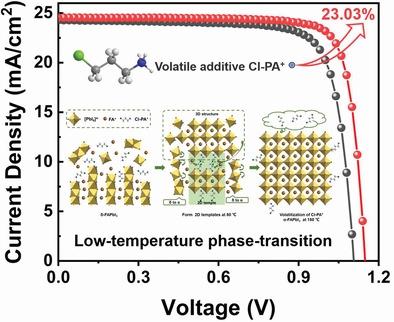当前位置:
X-MOL 学术
›
Small Methods
›
论文详情
Our official English website, www.x-mol.net, welcomes your
feedback! (Note: you will need to create a separate account there.)
Low-Temperature Phase-Transition for Compositional-Pure α-FAPbI3 Solar Cells with Low Residual-Stress and High Crystal-Orientation
Small Methods ( IF 10.7 ) Pub Date : 2022-09-26 , DOI: 10.1002/smtd.202200933 Ying Huang 1 , Jianghu Liang 1 , Zhanfei Zhang 1 , Yiting Zheng 1 , Xueyun Wu 1 , Congcong Tian 1 , Zhuang Zhou 1 , Jianli Wang 1 , Yajuan Yang 1 , Anxin Sun 1 , Yuan Liu 1 , Chen Tang 1 , Zhenhua Chen 2 , Chun-Chao Chen 1
Small Methods ( IF 10.7 ) Pub Date : 2022-09-26 , DOI: 10.1002/smtd.202200933 Ying Huang 1 , Jianghu Liang 1 , Zhanfei Zhang 1 , Yiting Zheng 1 , Xueyun Wu 1 , Congcong Tian 1 , Zhuang Zhou 1 , Jianli Wang 1 , Yajuan Yang 1 , Anxin Sun 1 , Yuan Liu 1 , Chen Tang 1 , Zhenhua Chen 2 , Chun-Chao Chen 1
Affiliation

|
Transition of δ-phase formamidinium lead triiodide (δ-FAPbI3) to pure α-phase FAPbI3 (α-FAPbI3) typically requires high processing temperature (150 °C), which often results in unavoidable residual stress. Besides, using methylammonium chloride (MACl) as additive in fabrication will cause MA residue in the film, compromising the compositional purity. Here, a stress-released and compositional-pure α-FAPbI3 thin-film is fabricated using 3-chloropropylammonium chloride (Cl-PACl) by two-step annealing. The 2D template of n = 2 can preferentially form in perovskite with the introduction of Cl-PACl at a temperature as low as 80 °C. Such a 2D template can guide the free components to form ordered α-FAPbI3 and promote the transition of the formed δ-FAPbI3 to α-FAPbI3 by reducing the phase transition energy. As a result, the obtained perovskite films via low-temperature phase-transition have a high degree of crystal orientation and reduced residual stress. More importantly, most of the Cl-PACl is volatilized during the subsequent high-temperature annealing process accompanied by the disintegration of the 2D templates. The residual trace of Cl-PA+ is mainly concentrated at the grain boundary near the perovskite surface layer, stabilizing α-FAPbI3 and passivating defects. Perovskite solar cell based on pure α-FAPbI3 achieves a power conversion efficiency of 23.03% with excellent phase stability and photo-stability.
中文翻译:

具有低残余应力和高晶体取向的复合纯 α-FAPbI3 太阳能电池的低温相变
δ 相甲脒三碘化铅 (δ-FAPbI 3 ) 向纯 α 相 FAPbI 3 (α-FAPbI 3 ) 的转变通常需要较高的加工温度 (150 °C),这通常会导致不可避免的残余应力。此外,在制造中使用甲基氯化铵(MACl)作为添加剂会导致膜中残留MA,从而影响成分纯度。在这里,使用 3-氯丙基氯化铵 (Cl-PACl) 通过两步退火制备应力释放且成分纯的 α-FAPbI 3薄膜。n = 2 的二维模板可以在低至 80 °C 的温度下通过引入 Cl-PACl 优先在钙钛矿中形成。这样的二维模板可以引导自由组分形成有序的α-FAPbI 3并通过降低相变能促进形成的δ-FAPbI 3向α-FAPbI 3的转变。结果,通过低温相变获得的钙钛矿薄膜具有高度的晶体取向和降低的残余应力。更重要的是,大部分 Cl-PACl 在随后的高温退火过程中挥发,伴随着二维模板的分解。Cl-PA +的残留痕量主要集中在钙钛矿表层附近的晶界处,起到稳定α-FAPbI 3和钝化缺陷的作用。基于纯α-FAPbI 3的钙钛矿太阳能电池实现了23.03%的功率转换效率,具有出色的相位稳定性和光稳定性。
更新日期:2022-09-26
中文翻译:

具有低残余应力和高晶体取向的复合纯 α-FAPbI3 太阳能电池的低温相变
δ 相甲脒三碘化铅 (δ-FAPbI 3 ) 向纯 α 相 FAPbI 3 (α-FAPbI 3 ) 的转变通常需要较高的加工温度 (150 °C),这通常会导致不可避免的残余应力。此外,在制造中使用甲基氯化铵(MACl)作为添加剂会导致膜中残留MA,从而影响成分纯度。在这里,使用 3-氯丙基氯化铵 (Cl-PACl) 通过两步退火制备应力释放且成分纯的 α-FAPbI 3薄膜。n = 2 的二维模板可以在低至 80 °C 的温度下通过引入 Cl-PACl 优先在钙钛矿中形成。这样的二维模板可以引导自由组分形成有序的α-FAPbI 3并通过降低相变能促进形成的δ-FAPbI 3向α-FAPbI 3的转变。结果,通过低温相变获得的钙钛矿薄膜具有高度的晶体取向和降低的残余应力。更重要的是,大部分 Cl-PACl 在随后的高温退火过程中挥发,伴随着二维模板的分解。Cl-PA +的残留痕量主要集中在钙钛矿表层附近的晶界处,起到稳定α-FAPbI 3和钝化缺陷的作用。基于纯α-FAPbI 3的钙钛矿太阳能电池实现了23.03%的功率转换效率,具有出色的相位稳定性和光稳定性。

































 京公网安备 11010802027423号
京公网安备 11010802027423号